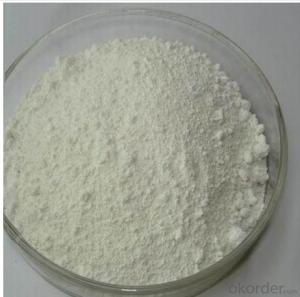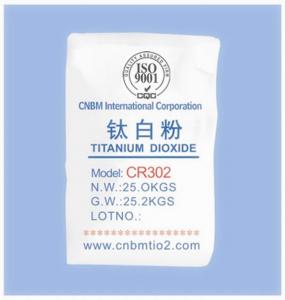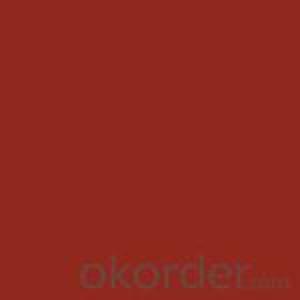Titanium Dioxide Rutile and Anatase Grade Powder
- Loading Port:
- Tianjin
- Payment Terms:
- TT OR LC
- Min Order Qty:
- 5000 kg
- Supply Capability:
- 1000000 kg/month
OKorder Service Pledge
OKorder Financial Service
You Might Also Like
Product introduction:
Titanium pigment called titanium dioxide is a kind of white pigment, with non-toxic, best best whiteness and brightness, opacity, is regarded as the performance in the world today one of the best white pigment, widely used in coatings, plastic, papermaking, printing ink, chemical fiber, rubber, enamel, ceramics, electronic ceramics, glass, alloys, welding wire, cosmetics and other industrial.
It has Rutile type titanium Rutile (R) and sharp type (Anatase type A) two types of structure, the Rutile crystal structure is compact, stable, small optical activity, and good weather resistance, and have higher hiding power, decolorization, and therefore have A better application performance, get more extensive application
Main features:
Superfine particle size
Excellent dispersion High tinting power High whiteness


Packaging:
Packed in 25kg PP/paper bag,22MT/1*20'FCL for rutile/anatase titanium dioxide/tio2 for high grade ceramics
Specifications:
Items | Rutile Titanium Dioxide | Anatase Titanium Dioxide |
m/m TiO2 content%≥ | 94 | 98 |
Tint reducing power European unit ≥ | 180 | 100 |
Whiteness % ≥ | 98.0 | - |
Dispersibility μm≤ | 12 | - |
Oil absorptiong/100g ≤ | 20 | 26 |
105Moisture % ≤ | 0.75 | - |
Specific resistance ΩNaN ≥ | 9000 | - |
Solution in water % ≤ | 0.3 | 0.5 |
Residue(45μm) ≤ | 0.01 | 0.1 |
PH value | 6.5-8.0 | 6.5-8.0 |
Volatile Matter(105D)≥ | - | 0.40 |

| : |
Product introduction: It is white powder,non-toxic and tasteless,having the good chemical stability,without the surface treatment anatase products,uniform particle size.It has excellent properties of pigment ,grade gloss ,high whiteness and blueish hue ,water dispersibility and hiding power etc.
Main features:
Superfine particle size Excellent dispersion High tinting power High whiteness
Packaging: Packed in 25kg PP/paper bag,22MT/1*20'FCL for rutile/anatase titanium dioxide/tio2 for high grade ceramics
Specifications:
ItemUnitTechnical indexTiO2 content (m/m) ≥%≥98.0Color(to standard) Not lower than L value%≥98.0Tint-reducing power (TCS Value) ≥Reynolds number(With the standard than)% ≥1350 ≥110 Oil absorption ≤g/100g≤21Volatile at 105°C≤%≤0.5Residue (325μm) ≤%≤0.07PH value 6.0-8.5
FAQ:
1.What is your advantages? We are the direct manufacturer , so the price will be much competitive.
2.What is your certificate? ISO9001 ISO14001 REACH SGS |
- Q: thank you very much for your help!
- Well photosynthetic pigments has to do with the different component of light (i.e. the colors - ROYGBIV) and their specific wavelenght. Photosynthetic pigments based on their colors can capture the energy from that wavelenght. For example fucoxanthin can capture the brown color of the light just like phycocyanin can capture the blue color of the light. These photosynthetic pigments are usually the accessory pigments of Chlorophyll A which is the main pigments of most of the photosynthetic organisms in the earth.
- Q: (Explain what happens when a pigment molecule is struck by electromagnetic radiation in the visible light spectrum.)
- pigments are molecules that absorb electromagnetic radiation. For example, the chlorophyll pigment in plants absorbs blue and red light, which is why they reflect green light (since green is the color not absorbed). Another example is melanin, which is the pigment that darkens the skin of people. Melanin absorbs UV to protect the skin. A pigment molecule struck by EM radiation in the visible region may absorb some of the light depending on what pigment it is.
- Q: How to manufacture FRP pigments?
- Pigment A finely divided material which contributes to optical and other properties of paint, finishes, and coatings. Pigments are insoluble in the coating material, whereas dyes dissolve in and color the coating. Pigments are mechanically mixed with the coating and are deposited when the coating dries. Their physical properties generally are not changed by incorporation in and deposition from the vehicle. Pigments may be classified according to composition (inorganic or organic) or by source (natural or synthetic). However, the most useful classification is by color (white, transparent, or colored) and by function. Special pigments include anticorrosive, metallic, and luminous pigments. See also Dye; Luminous paint; Paint.
- Q: If you could explain it to me I would be very happy!
- Accessory pigments are light-absorbing compounds, found in photosynthetic organisms, that work in conjuction with chlorophyll a. They include other forms of this pigment, such as chlorophyll b in green algal and higher plant antennae, while other algae may contain chlorophyll c or d. In addition, there are many non-chlorophyll accessory pigments, such as carotenoids or phycobiliproteins which also absorb light and transfer that light energy to photosystem chlorophylls. Some of these accessory pigments, particularly the carotenoids, also serve to absorb and dissipate excess light energy, or work as antioxidants.
- Q: a question on my photosynthesis test review...=_=
- How Pigments Work
- Q: I have dyed my hair dark brown for months now it keeps fading because i've had bleach on before hand, so I need some advice on buying decent hair dyes for pre-pigmenting it so my hair dye stops fading out into a horrible gingery brown!
- if you have blonde hair this will naturally get bleached by the actual sun in the summer. There was this guy in my class who also had golden blonde hair that has been a medium brown near the base. When he came back to college after summer vacation, it was practically platinum blonde!
- Q: Pleaseeeeee answer A.S.A.P Pleaseeee! Are pigments haram?
- Most pigments for dyes and paints come from plants or minerals. What exactly do you need? The second part of your question about haram, needs some explanation, too.
- Q: What is pigment?
- Those are M.A.C. Pigments which are mineral powders that are very rich in color and shine. They can be used a myriad of ways and with so many different mediums. They can be used instead of eyeshadow or with it. It can go over creme based shadows. I have added M.A.C. pigments to body creme's, lip glosses, hair gels, nail polish (both clear and color). I've used them as highlighters for face and body. You can use them for virtually just about anything. They are one color when dry but tend to intensify when wet. It's a very versatile product. Lots of fun and tends to become a collectors item to many. For more on M.A.C. Pigments go to specktra / and register. It's basically a pro-M.A.C. site where you can even purchase samples of pigments. Hope you found this helpful, LR
- Q: Hi what is pigment?i went on mac cosmetics and they sell all different kinds of stuff called pigment. I want to use it to make lip gloss but is it safe for my lips?please answer soon!
- pigment is just color. the color shown or what makes a color. MAC is GREAT!!!!! its a color used to product a color or the actual color itself. either way....pigment means color.
- Q: How can you extract pure pigments from a sample of leaves in a form that you could test the absorbency of the various pigments??I don't know how to extract enough pigment in order to fill a cuvette and measure the absorbance, please help!! :D
- Separation of plant pigments using chromatography. Paper chromatography is a useful technique in the separation and identification of different plant pigments. In this technique, the mixture containing the pigments to be separated is first applied as a spot or a line to the paper about 1.5 cm from the bottom edge of the paper. The paper is then placed in a container with the tip of the paper touching the solvent. Solvent is absorbed by the chromatographic paper and moved up the paper by capillary action. As the solvent crosses the area containing plant pigment extract, the pigments dissolve in and move with the solvent. The solvent carries the dissolved pigments as it moves up the paper. The pigments are carried along at different rates because they are not equally soluble. Therefore, the less soluble pigments will move slower up the paper than the more soluble pigments. This is known as developing a chromatogram.
Send your message to us
Titanium Dioxide Rutile and Anatase Grade Powder
- Loading Port:
- Tianjin
- Payment Terms:
- TT OR LC
- Min Order Qty:
- 5000 kg
- Supply Capability:
- 1000000 kg/month
OKorder Service Pledge
OKorder Financial Service
Similar products
Hot products
Hot Searches
Related keywords



























